This is a detailed guide covering how to pack a saxophone for shipping. I will also discuss shipping and insurance options at the end. I am including lots of photos, so that people who are not familiar with saxophones at all can still figure out exactly how to do a great job shipping one.
A saxophone is a thin brass tube with lots of moving parts attached to it. Brass is a soft metal, so that means that saxophones are pretty easy to damage. They require more care in packing than guitars, other woodwinds, or just about any other shippable musical instrument.
Many saxophone are damaged in shipping each year, and the great majority of this damage is easily preventable if you follow some key packing tips. So if you have a saxophone to pack, please read these tips carefully and don’t skip or modify any of them. Every step is necessary if you want to avoid shipping damage. Don’t count on insurance to cover you. Take the time to pack well.
First, some general things to keep in mind.
- Use a large, sturdy box. Don’t skimp on box size. The padding around the case inside the box is what protects the horn from shocks. A nice, large box with soft padding is your best insurance.
- It is good to ship a saxophone in its protective case, BUT the case is the thing most likely to damage your saxophone in shipping. You have to pack it well inside the case. You can also ship with no case, but you have to double-box very exaggeratedly, with a case-sized inner box, and a much larger, sturdy outer box full of lots of soft packing material on every side.
Now, on to the detailed instructions! First, we will pack inside the case. Then, we will pack outside the case.
INSIDE THE CASE
What you’ll need:

1. Secure all loose items in the case by wrapping them in padding (paper towels, news paper, or thin bubble wrap) and putting them in a bag in the storage compartment of the case.


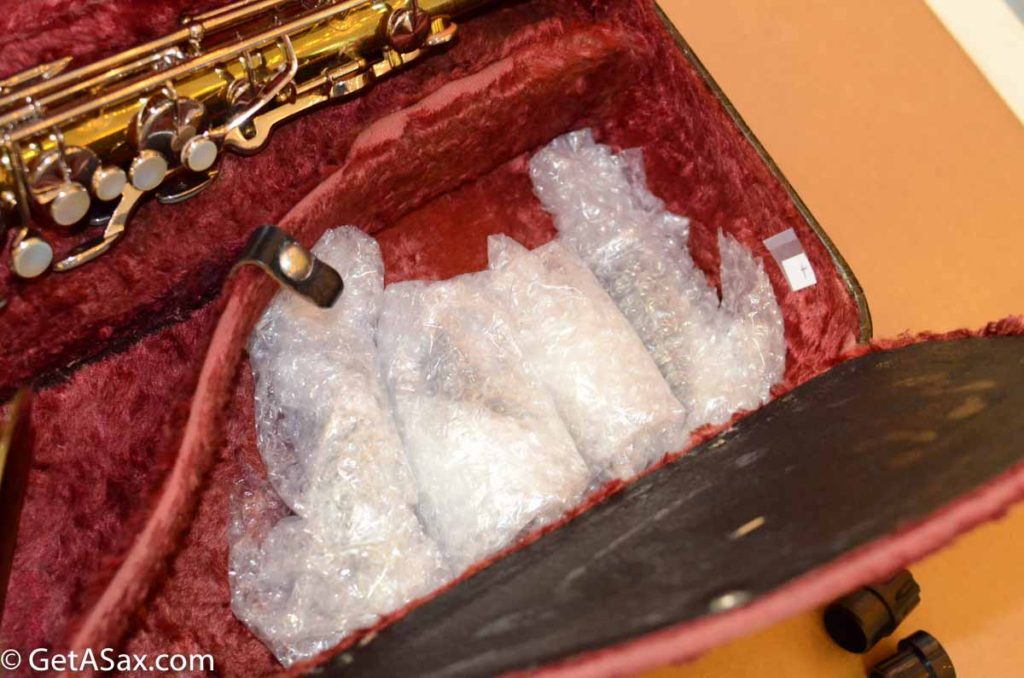
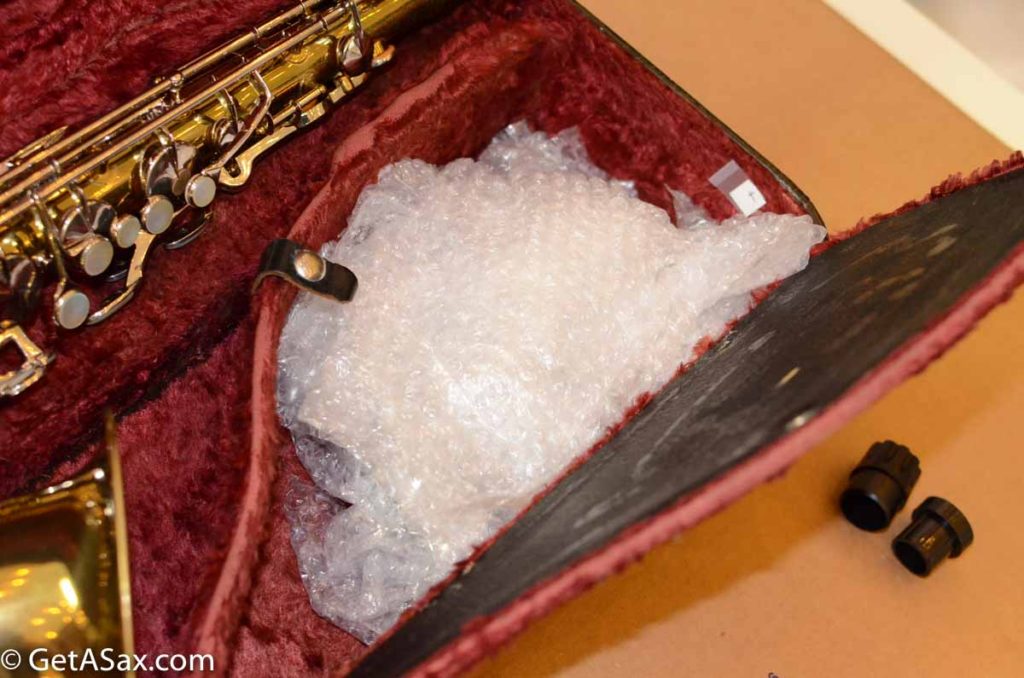
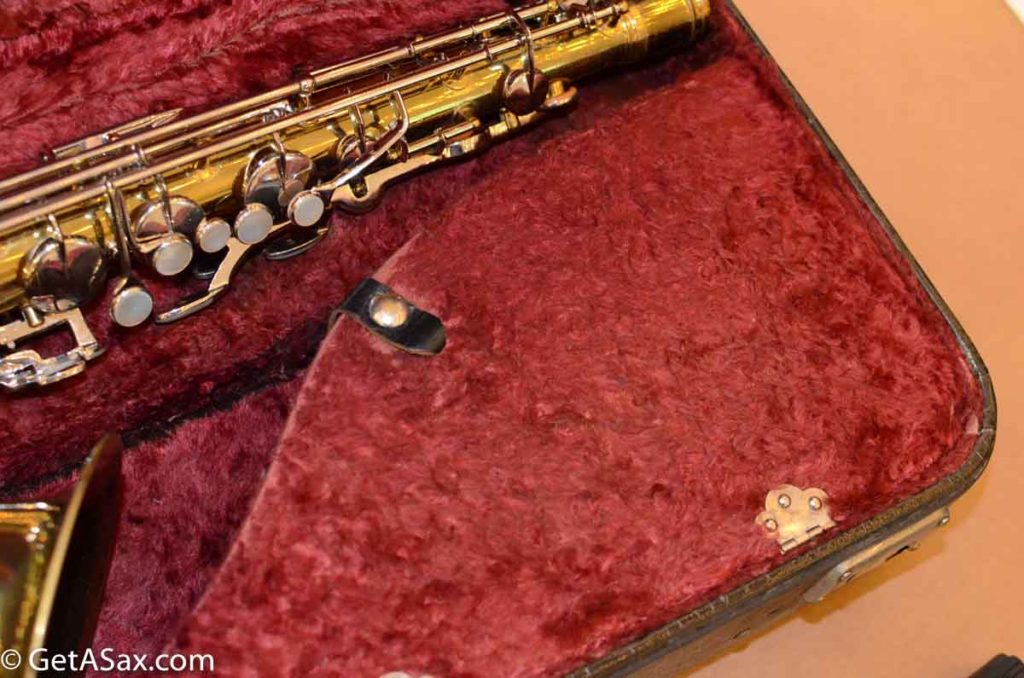
2. Put the endplug (a small cylinder about one inch diameter) INTO the top of the saxophone body to protect the octave lever that sticks out. This is an end plug. It might also be metal or wood. If your saxophone does not have an end plug, you can buy one, or even make one out of a wine bottle cork wrapped several times on one end with duct tape to make it thick enough to work as a stopper on one end.
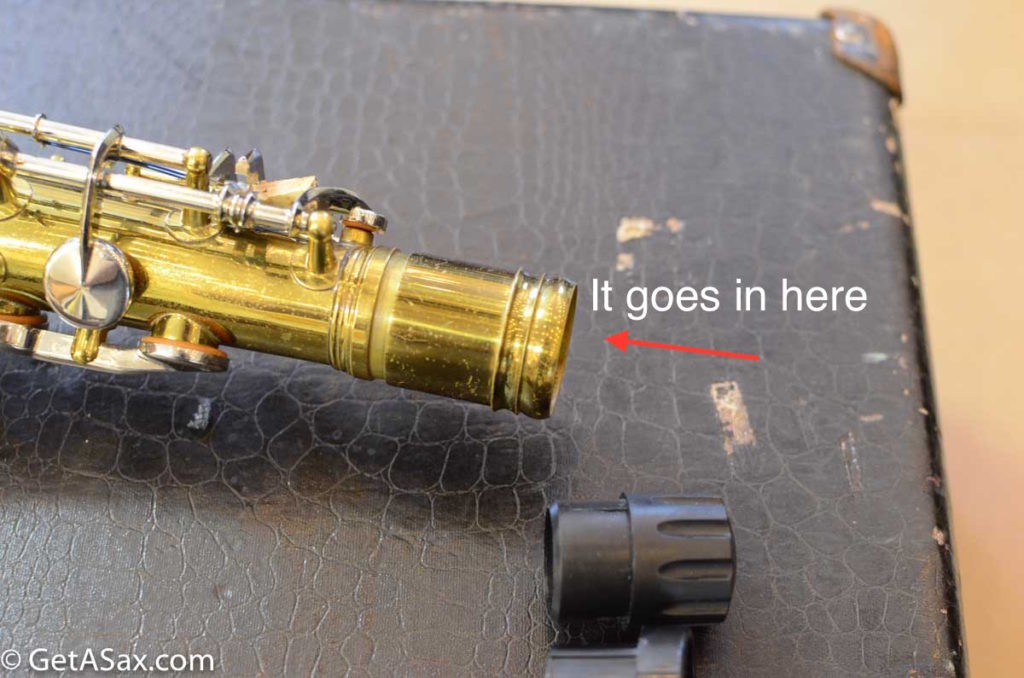
3. **SKIP Steps 3-5 if your sax is not in good playing condition, or if you don’t feel comfortable doing it. It’s the least important step** Cork the keys for shipping using small wedges of cork if the horn is in good playing condition, and if you know how to do this correctly. You can cut them like pizza slices out of a cross section of a wine cork, or cut them out of a scrap piece of dense foam.
4.**SKIP Steps 3-5 if your sax is not in good playing condition, or if you don’t feel comfortable doing it. It’s the least important part.**
Hold each key closed and insert the wedge under the key “foot” on the other side of the body from the key touch.


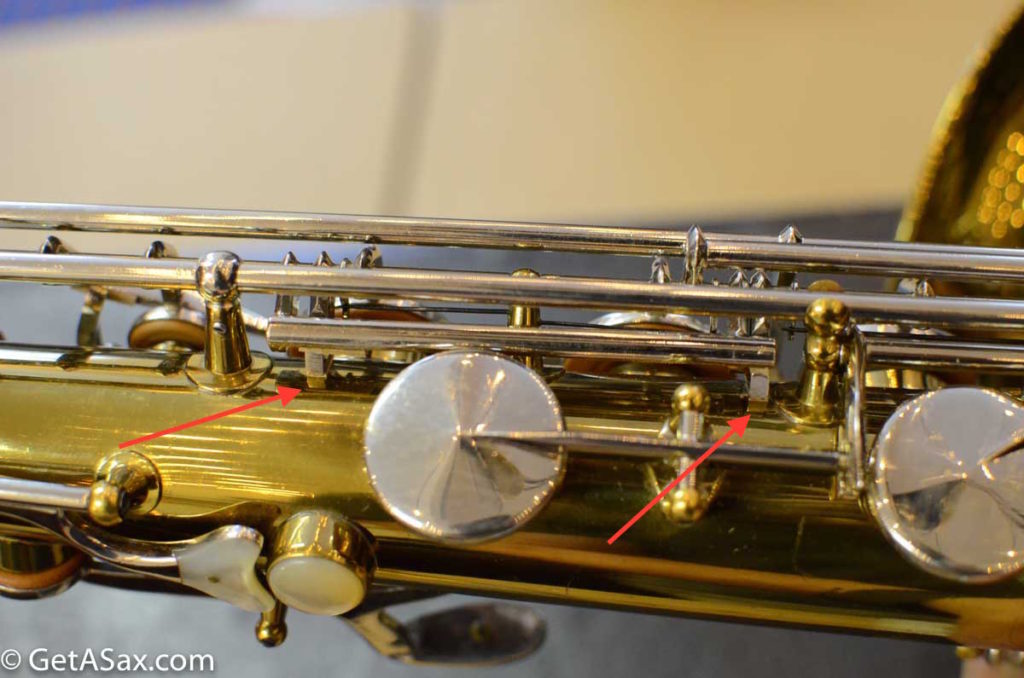
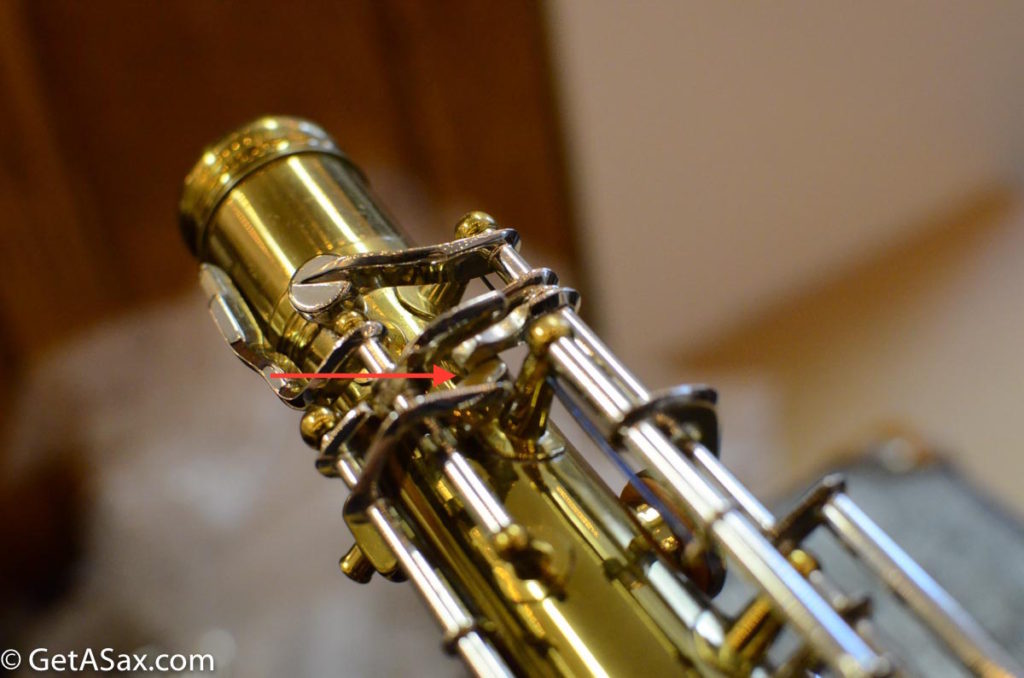
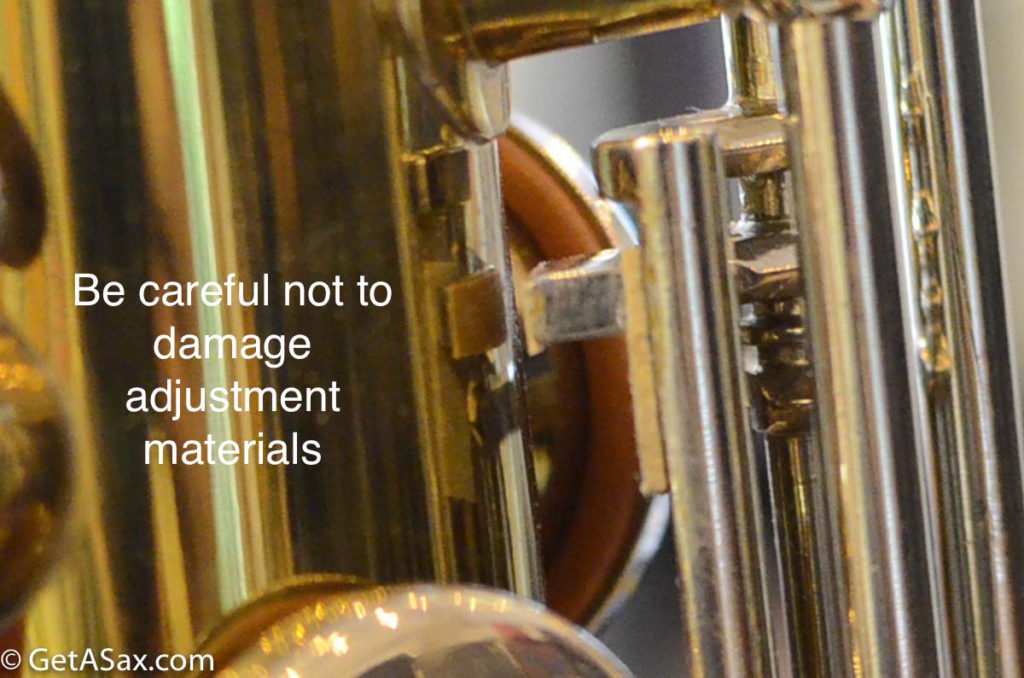

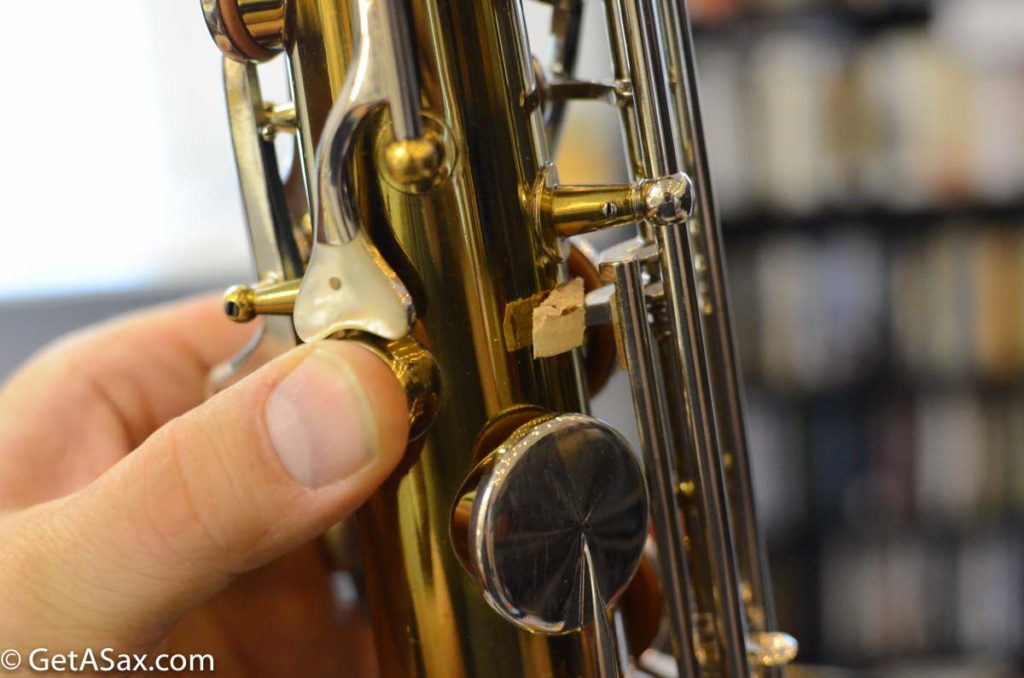

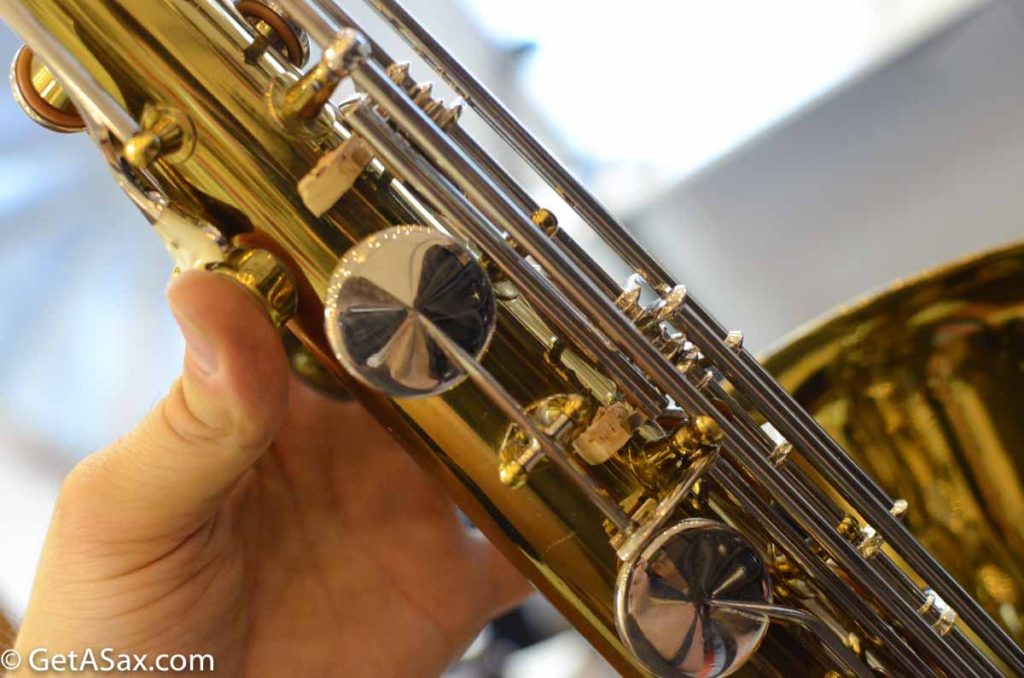
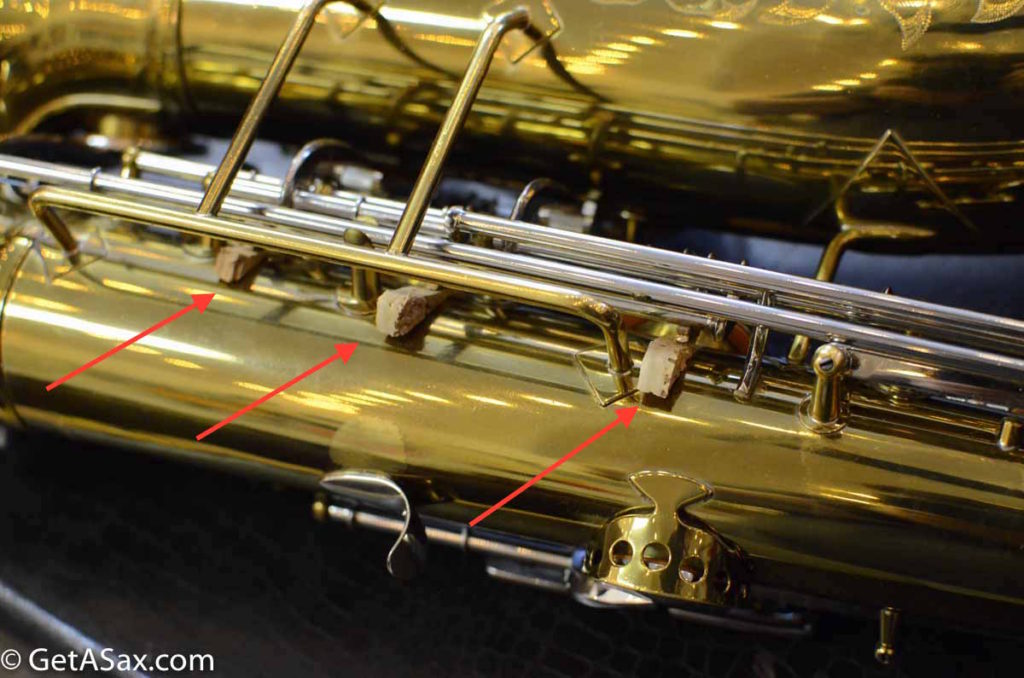
5. Close the larger keys with little foam or styrofoam bumpers.
IF YOU SKIPPED STEPS 3-5 Continue here.
Step 6. Wrap the neck and put it in the storage compartment or stick it down inside the bell.
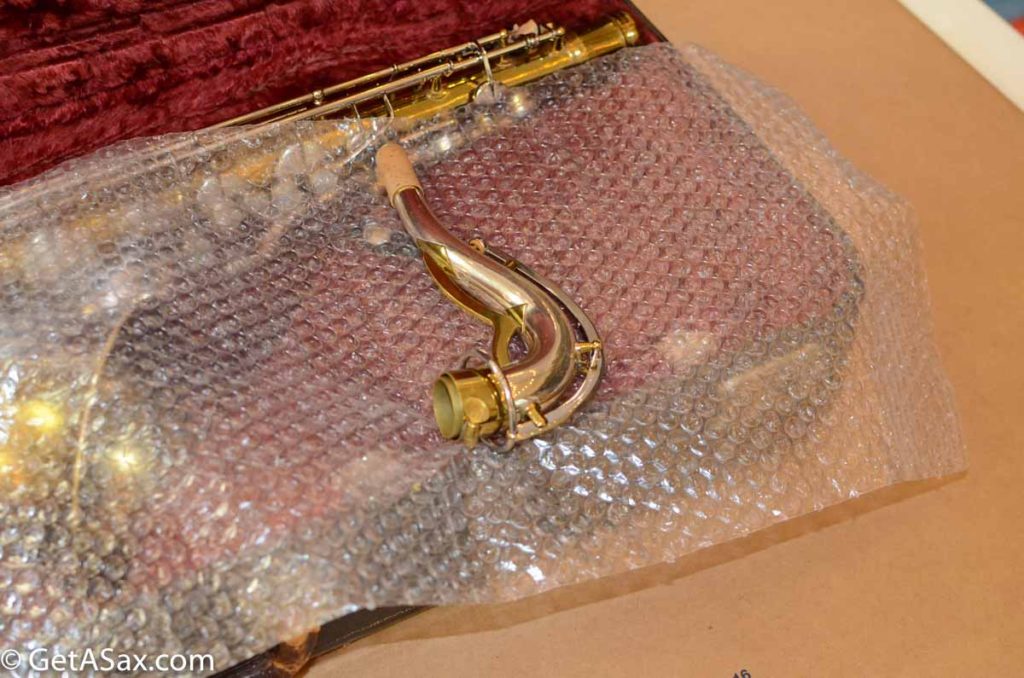
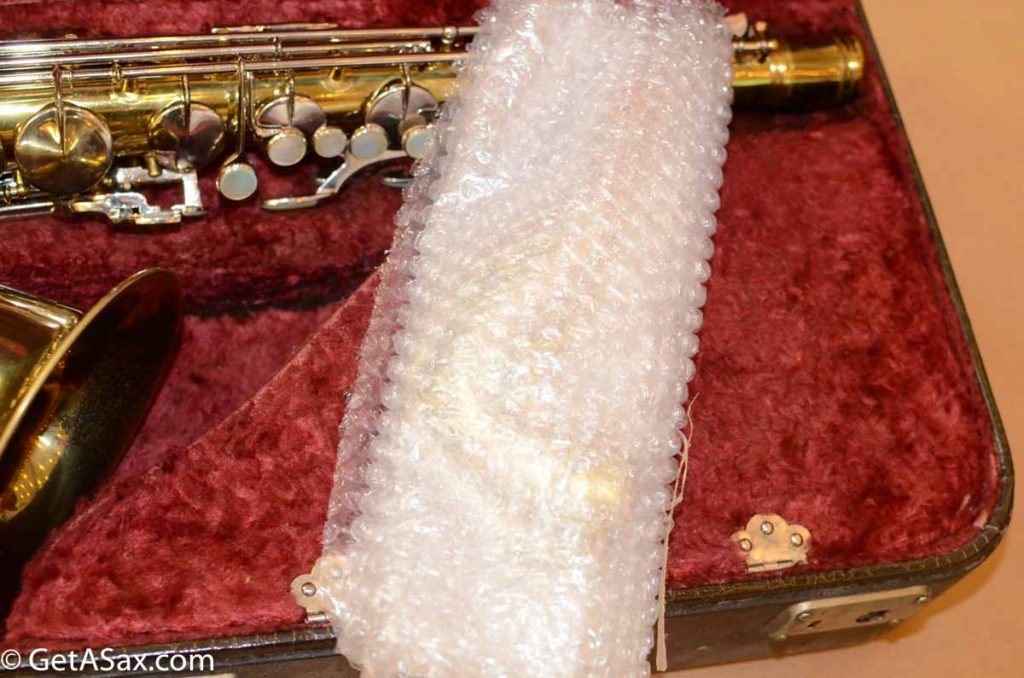
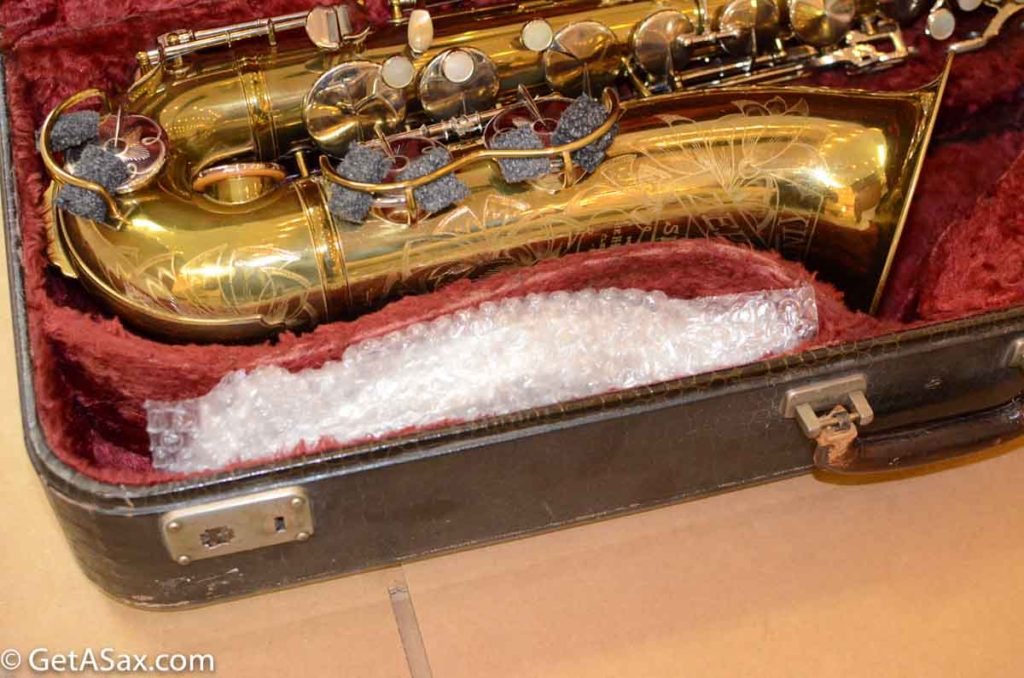
7. Use thin bubble wrap to pad under the horn, especially under the bell, and around the bottom bow. Use enough packing to fill all void space in the case, so that the horn is SNUG in there. If you shake the case, nothing should be able to move inside.
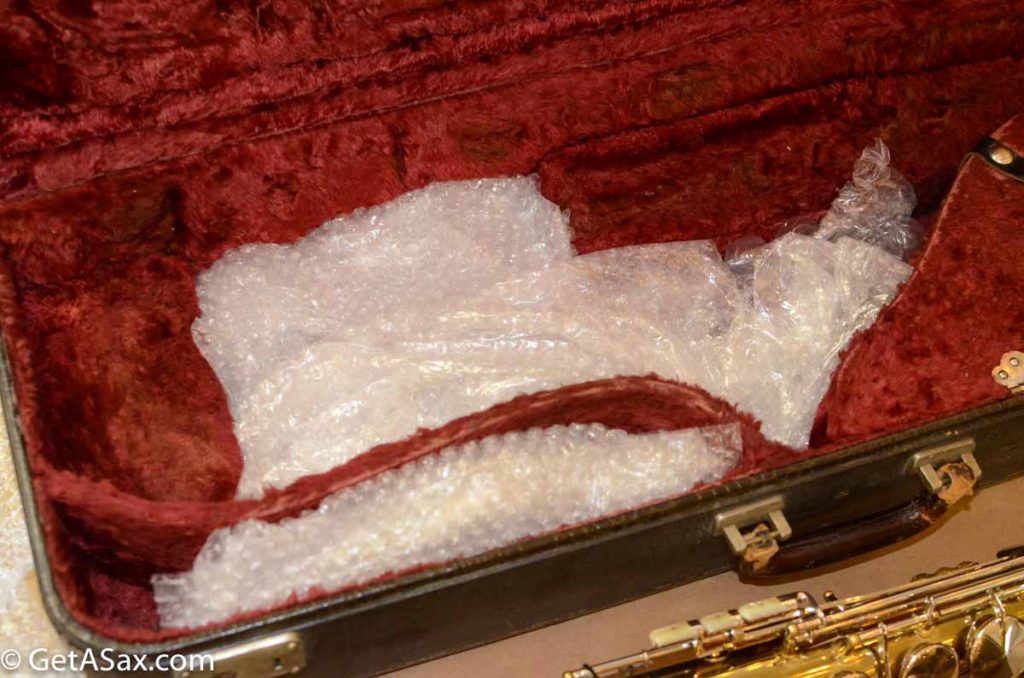
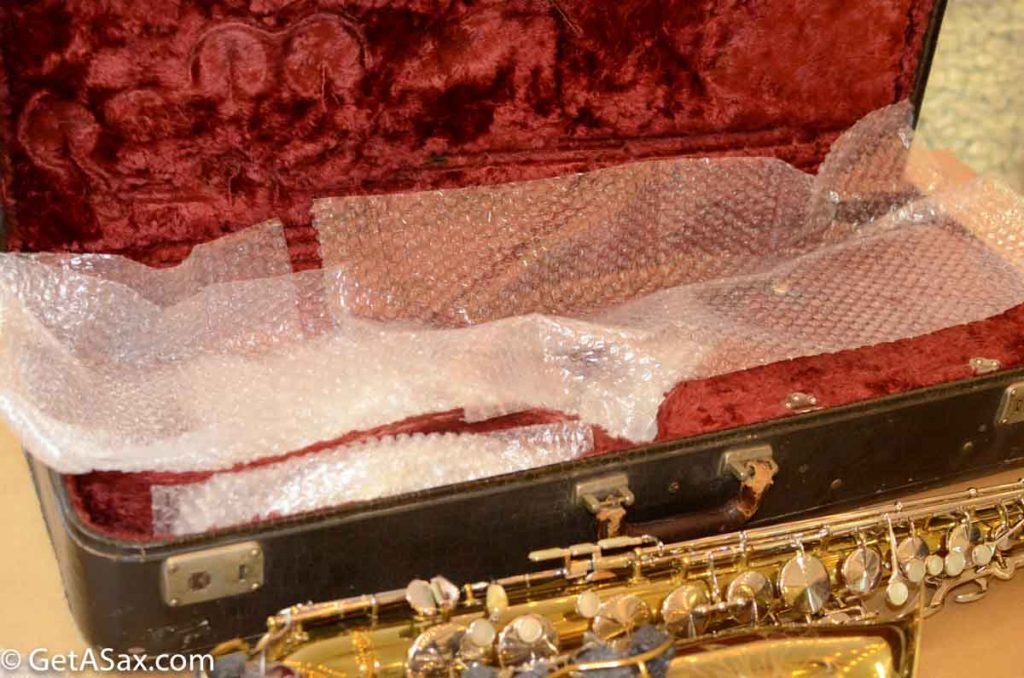

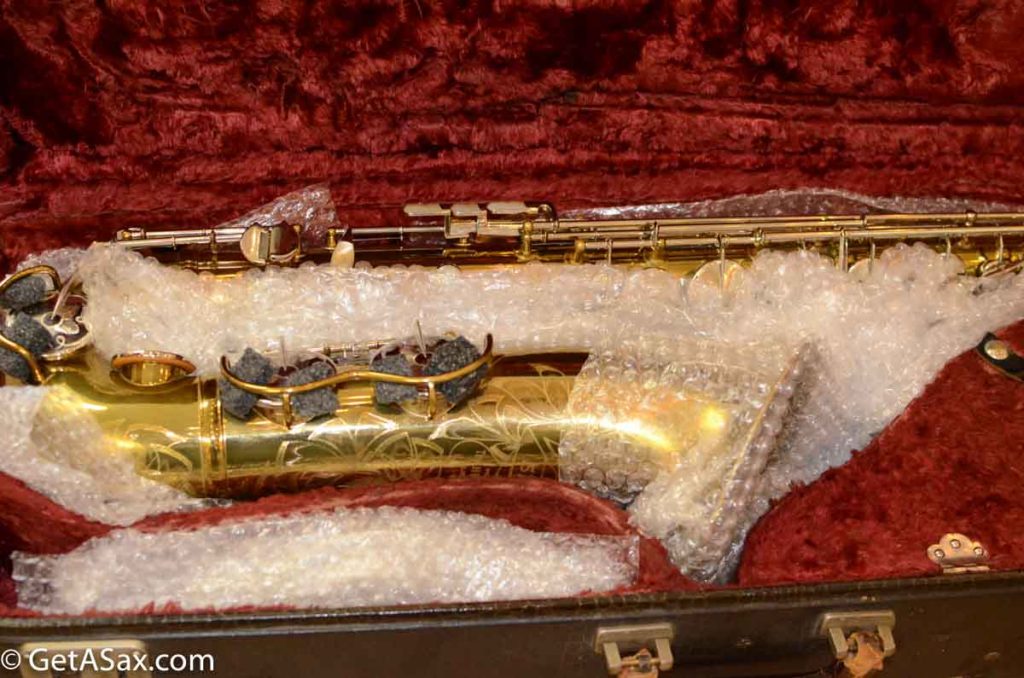
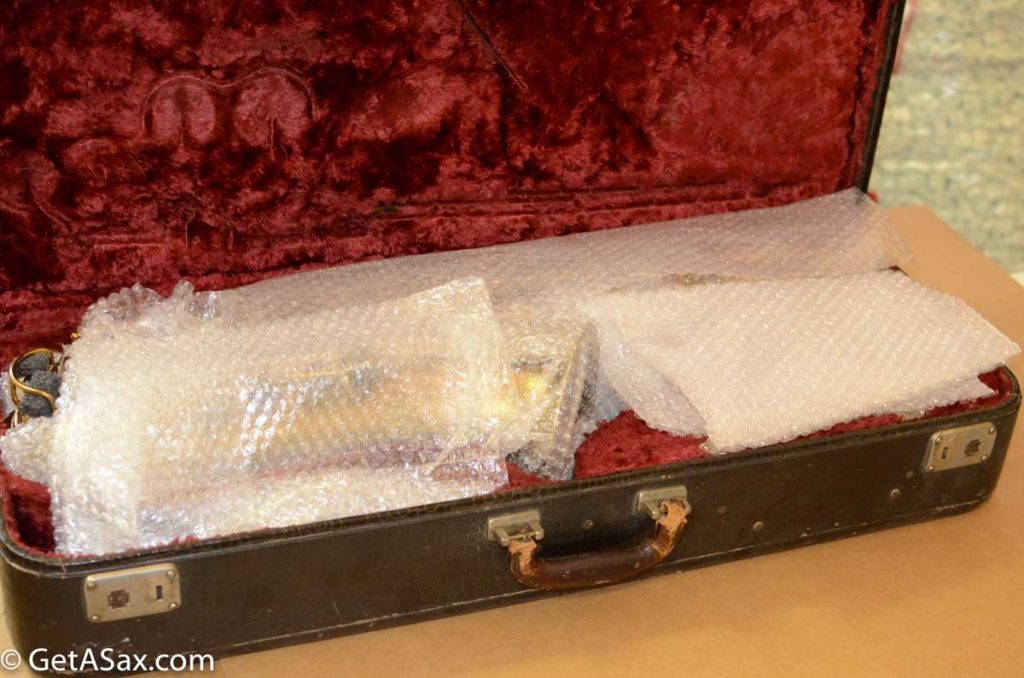
7. Do not overpack: the lid of the case should still close easily, and the horn should not be so tight that keys could be bent. Gently tape latches closed.
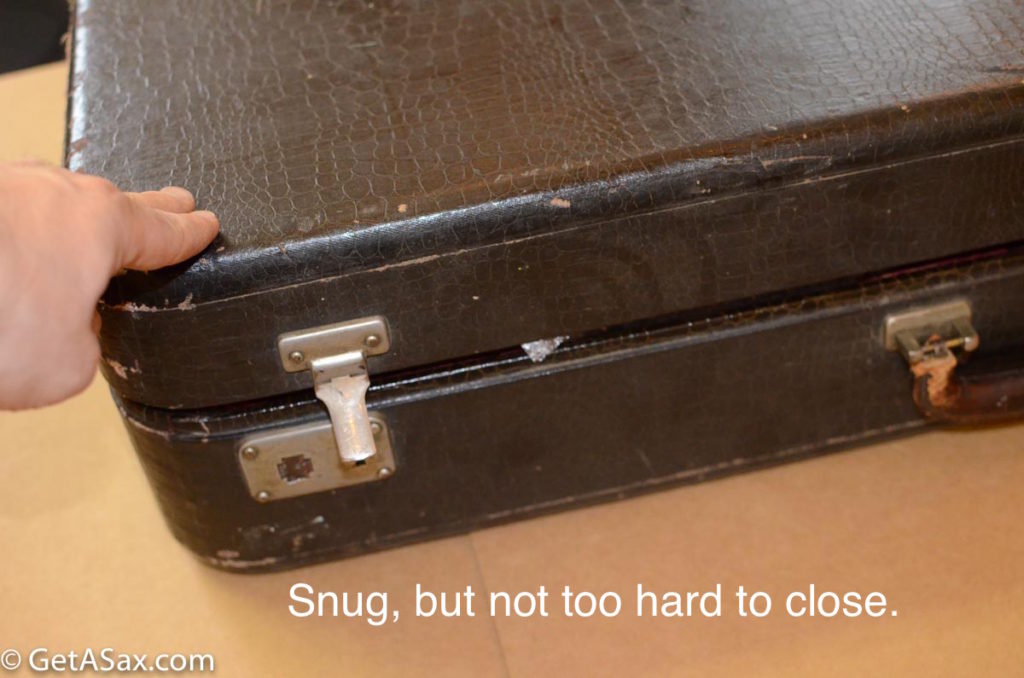
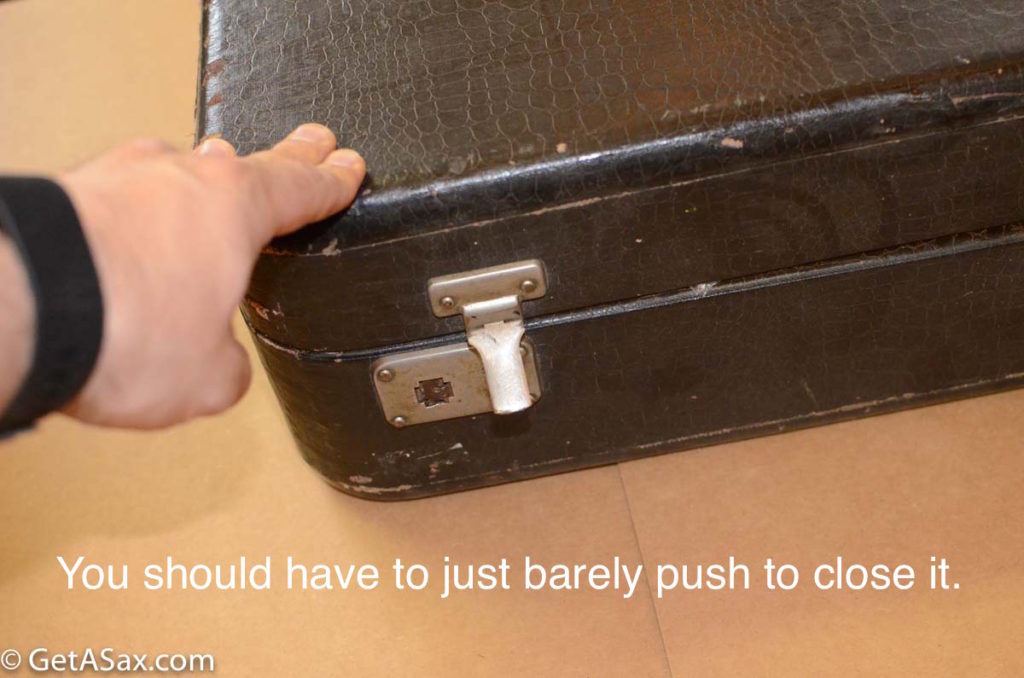
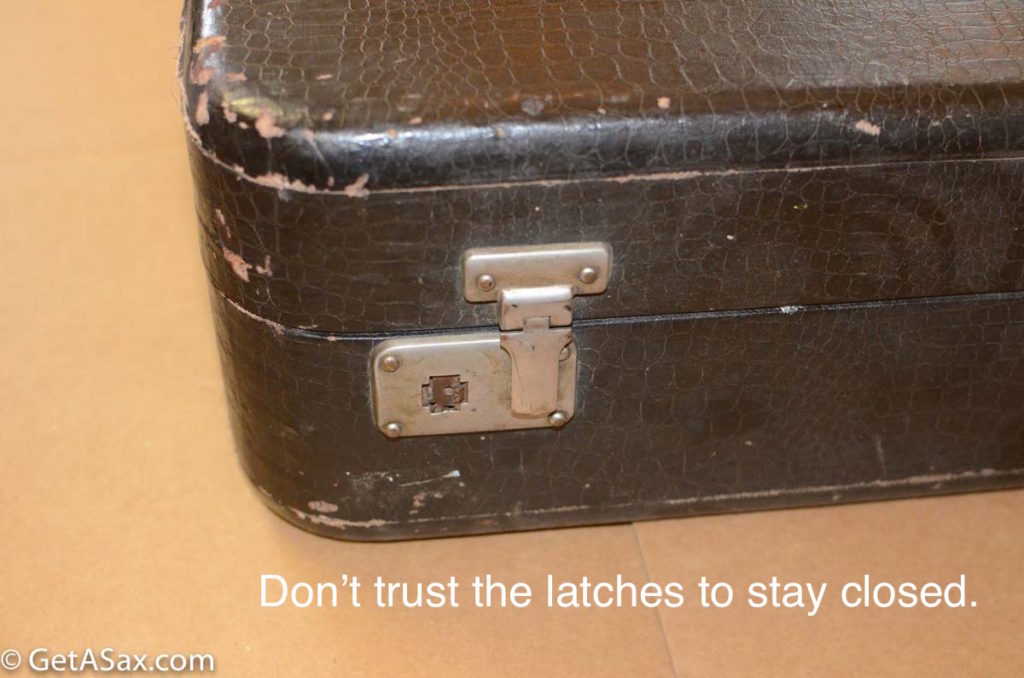
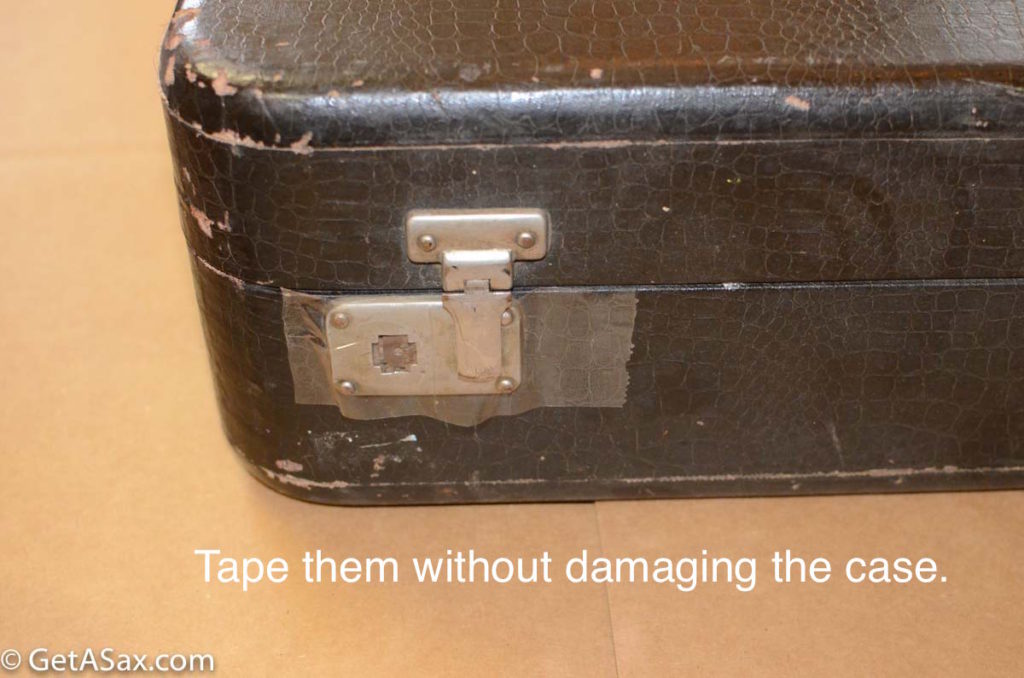
OK you are now 3/4 of the way done! Good work so far.
Step 8: Packing around the case inside the box:
1. If you have a FedEx/Kinko’s store nearby, my recommendation is to take advantage of their “fragile pack” service. It should cost between $19.99-$24.99. This includes both materials and labor, and it is a great deal. Call before going, and ask if they have their “golf clubs box.” This is a 48x16x16″ box that can easily be cut down to 38″ for tenor, and 32″ for soprano or alto. It is a double-walled box that is super-strong and protective. Use it if you can. Ask for bubble wrap inside the box around the case if they have it, or use whatever they suggest.
If you don’t have a FedEx/Kinko’s nearby, no problem. You can use a local pack and ship store (print out these instructions, so they use a BIG box.) Or do it yourself and follow the rest of the instructions. The U-Haul store’s medium wardrobe box works well for shipping a baritone saxophone.

Step 9. Place it in a nice, new (preferably double-walled) box that is at least the following size:
Soprano: 32″x12″x12″
Alto: 32″x16″x12″
Tenor: 36″x16″x12″
Baritone: 48″x18″x16″
If you have trouble finding a box at at UPS store or similar, then buy a dishpak box from your local U-Haul store. It is double walled and will hold soprano, alto or tenor. For a baritone, get the U-Haul large wardrobe box. Because it is so large and sturdy, it is also ideal for shipping a horn without a case, should you be in the difficult situation of having to do that.
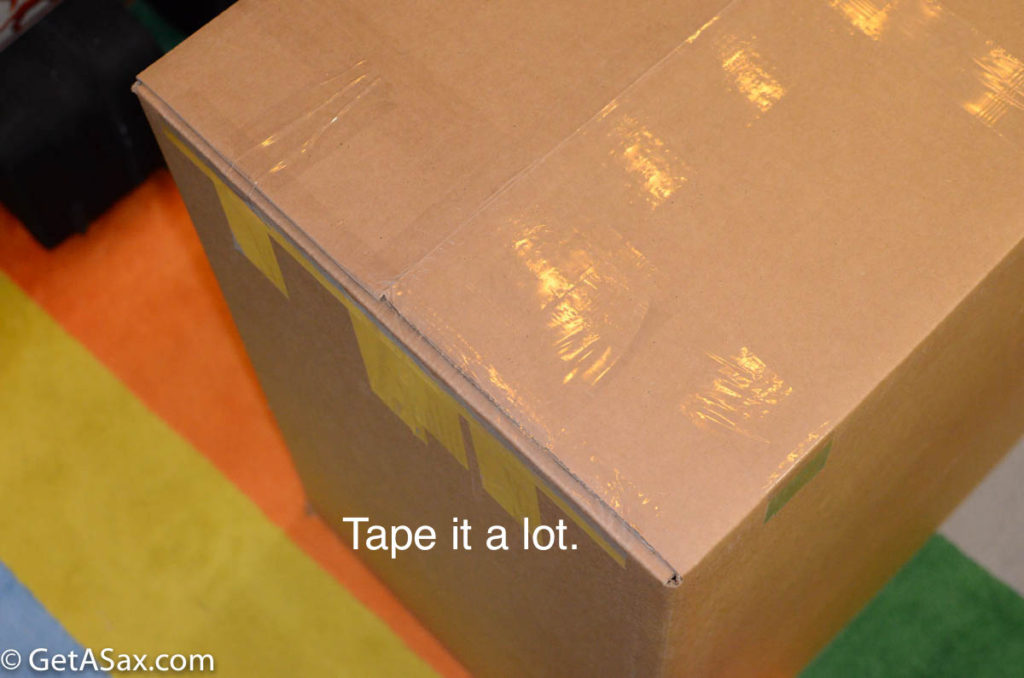
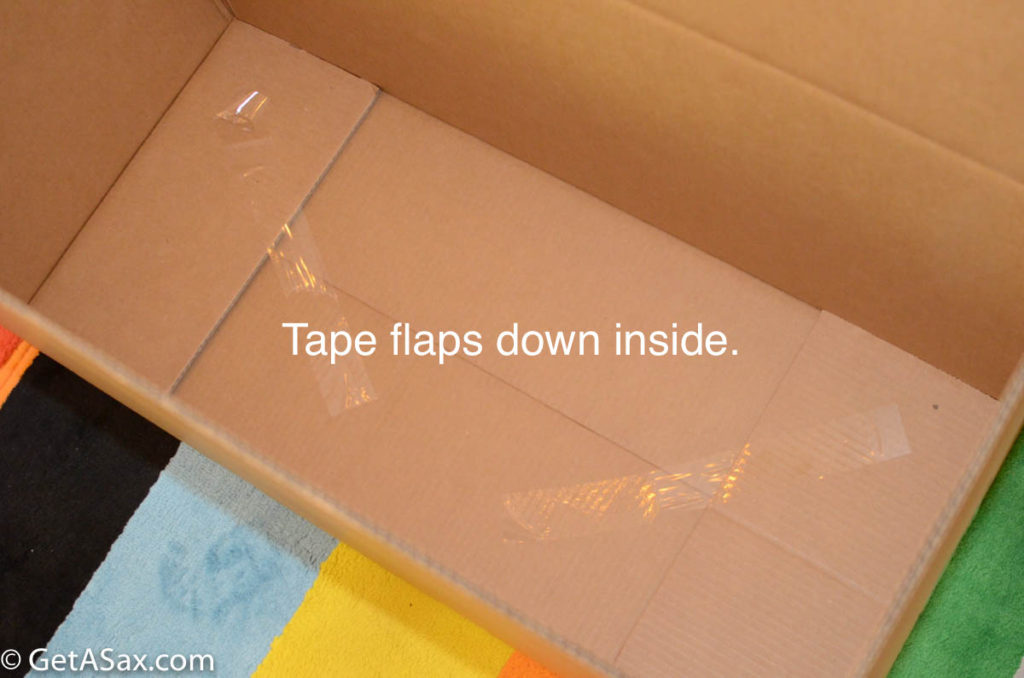

10. Pad around the case with at least 3″ of thick bubble wrap or styrofoam packing peanuts (these green ones are recycled!). You can buy them in bulk from warehouse stores (Costco, Sam’s Club), or find them on free cycle or craigslist to reuse. You can even use 3″ thick soft mattress foam, but packing peanuts are best. If you don’t have enough peanuts, wrap around the case in thick bubble wrap a few times. Don’t use a bunch of the large air pillows from Amazon, because those can easily pop, leaving your case rattling around in the box.
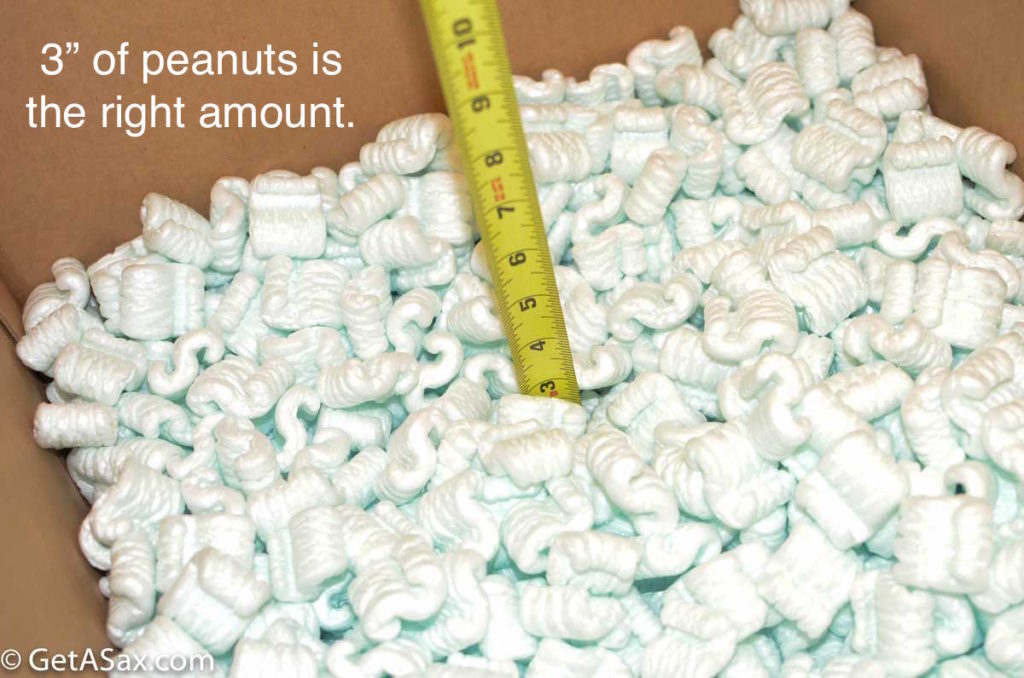
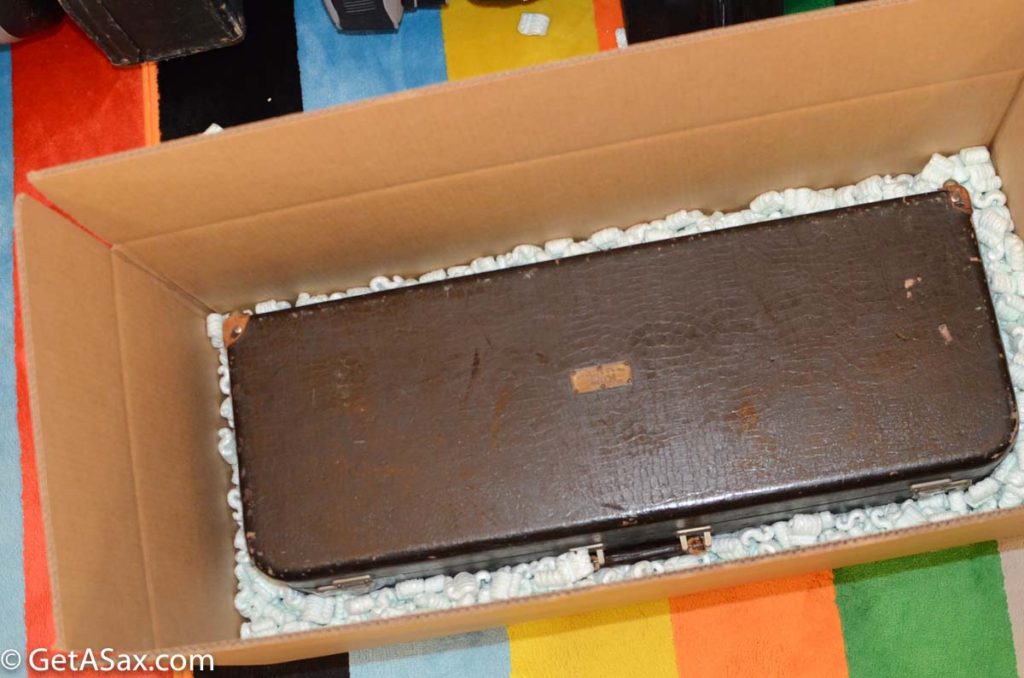
10. FILL the box TOTALLY full of packing peanuts. Do not use wadded paper, or this will invalidate your insurance if you ship UPS or FedEx. The more peanuts you add, the more rigid the box will be. A box that is totally full becomes quite strong and can support a lot of weight. A box that is 90% full crushes immediately.
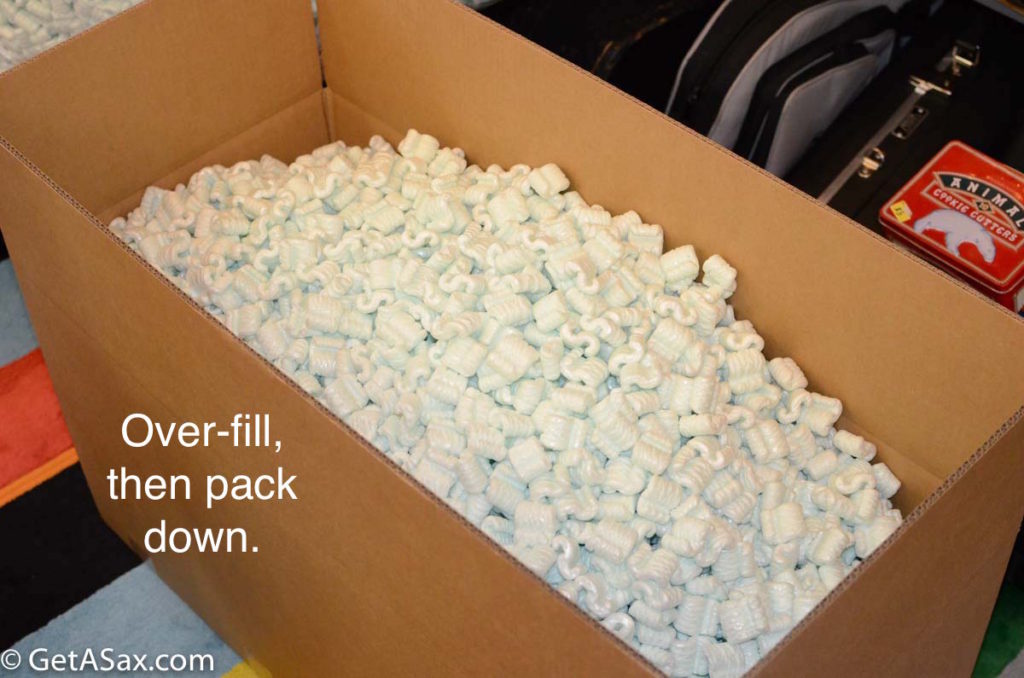
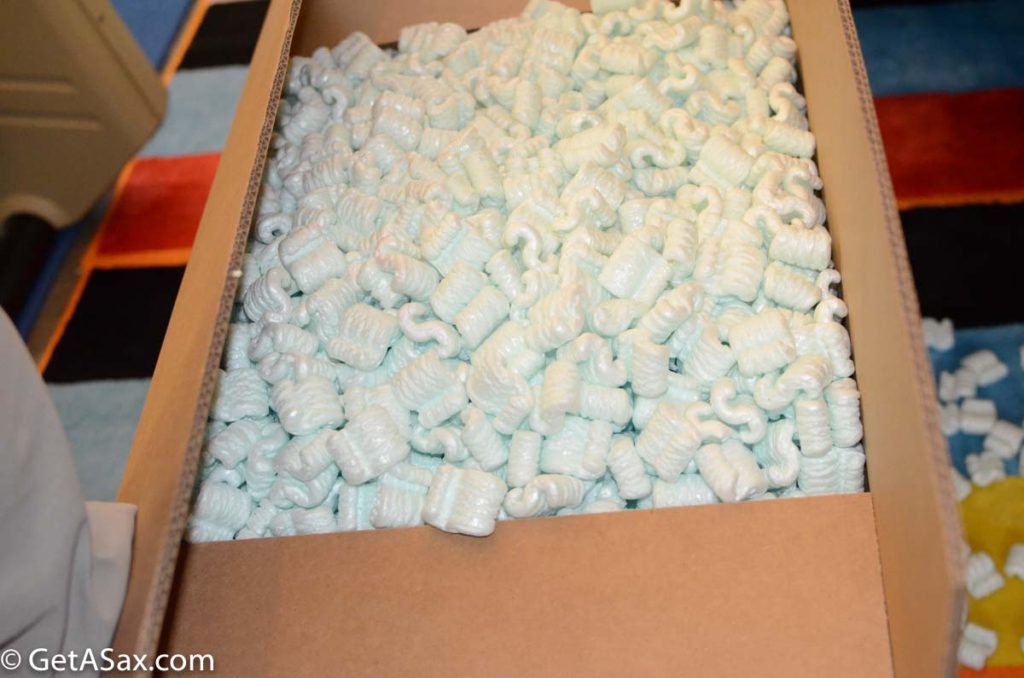

11. Mark the package fragile. Write the addresses on the box in sharpie in case the label gets damaged. Tape over your label just to be safe.
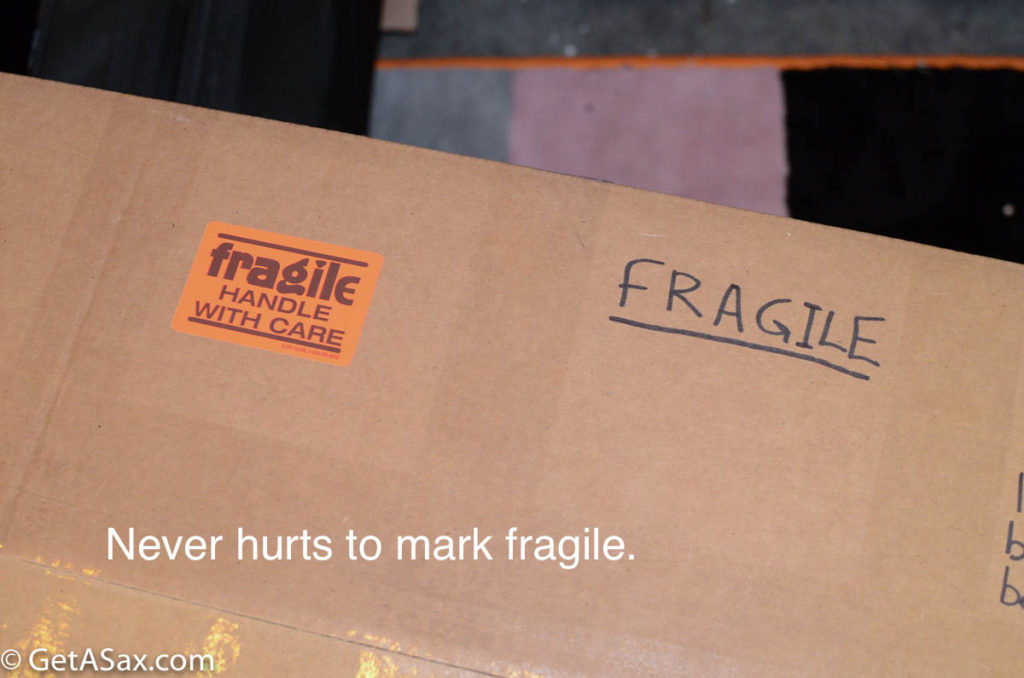
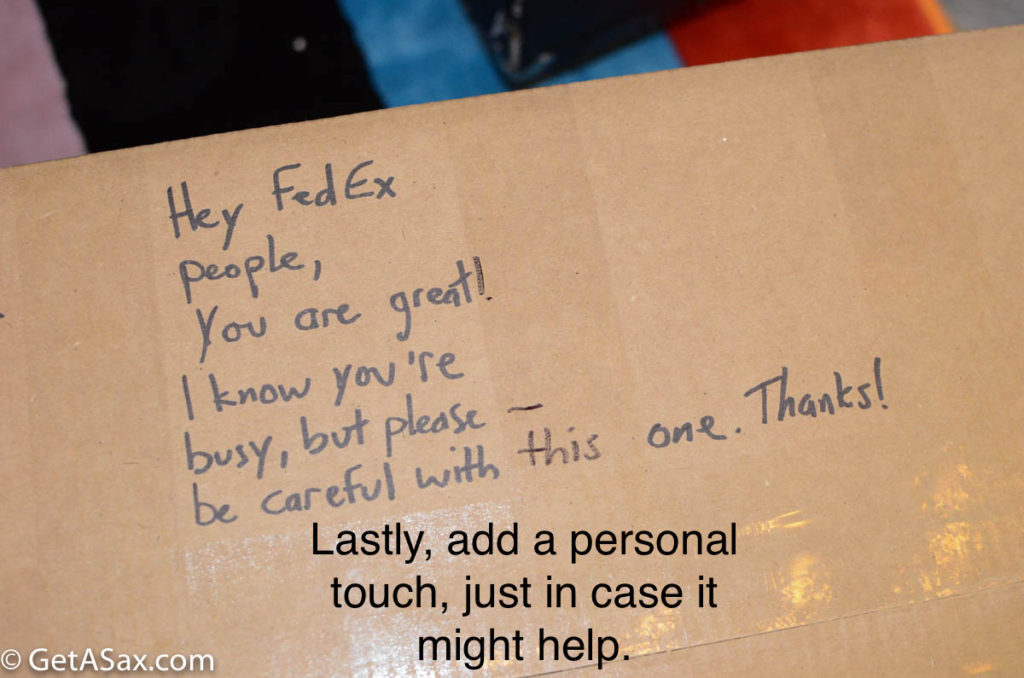
Shipping and insurance options:
Some people love or hate one or more of the major shippers. I have used all three many hundreds of times each, and find the problems to be fairly evenly spread among the three.
FedEx: If you want to pay for shipping in person, FedEx ground purchased at the FedEx store is the way to go. If you have a FedEx Kinkos, you can get the Fragile Pack and shipping at the same time in one trip. The ‘golf clubs box’ works best for saxophones. Insist on that box. Be aware that FedEx insurance does not cover musical instruments more than 20 years old, so decline it if your saxophone is older because you are literally paying for nothing. You can buy insurance separately online for any shipment through websites like ShipCover using the tracking number (after you have it).
UPS: If you can print your label online, this is great. I usually recommend avoiding the UPS stores as they try to upsell you on everything. They are a separate company and will charge you outrageously high amounts for their proprietary insurance, and the UPS stores (as opposed to UPS shipping depot and not UPS.com) will also try to insist that they pack it. Skip this and pay for shipping and insurance through UPS website if possible. UPS Ground is usually 1-2 days slower than FedEx ground for anything more than a few states away. 3-day select is also worth a look if you want UPS air shipping and is way cheaper than FedEx air.
USPS: USPS Priority Mail and Priority Mail Express services are typically very reliable ways to ship a saxophone. They are usually more expensive than FedEx or UPS ground services because they are air mail, but they are less expensive than any UPS or FedEx air option. Insurance through USPS can get expensive quickly (+$67 for $5k insurance).
I like to use Express mail to ship saxophones that are already in top playing condition, because it gets there in 1 day and is handled fairly gently. This is also handy where otherwise it would be bumping around in a hot UPS truck for several days in the summer, or getting very cold in the winter for long periods. Saxophones are not that temperature-sensitive, but if they get too hot, it can cause the pads to move and leak. The 2-3 day USPS Priority Mail option is surprisingly cheap for shipping between contiguous states. Sometimes even under $10 for a large box! These are both fairly good for international as well, though they have strict size limits to some countries that can rule out shipping tenors and baritones there.
Well, there you go. That should be just about everything you need to know to ship a saxophone safely. Let me know in the comments if I left out anything important, or if something was confusing. Happy shipping!

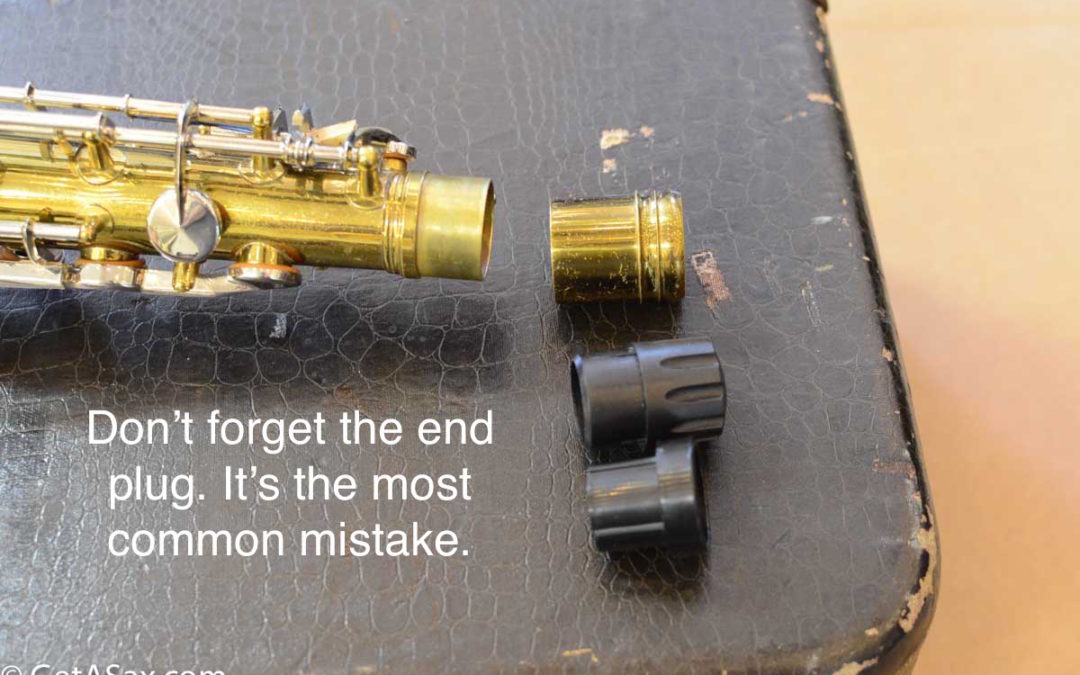
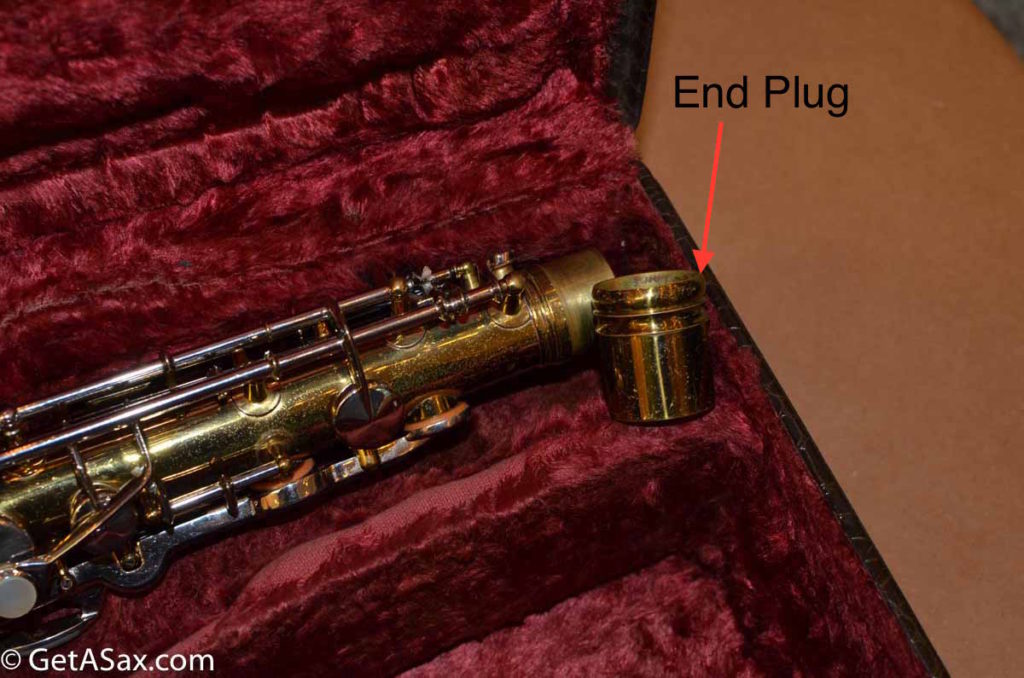
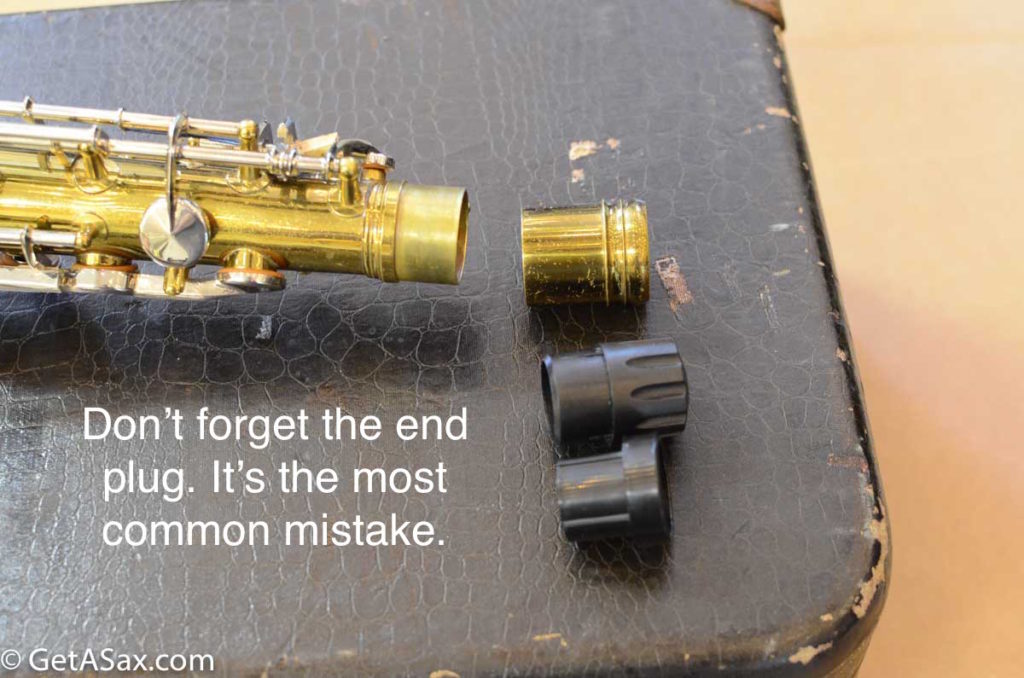



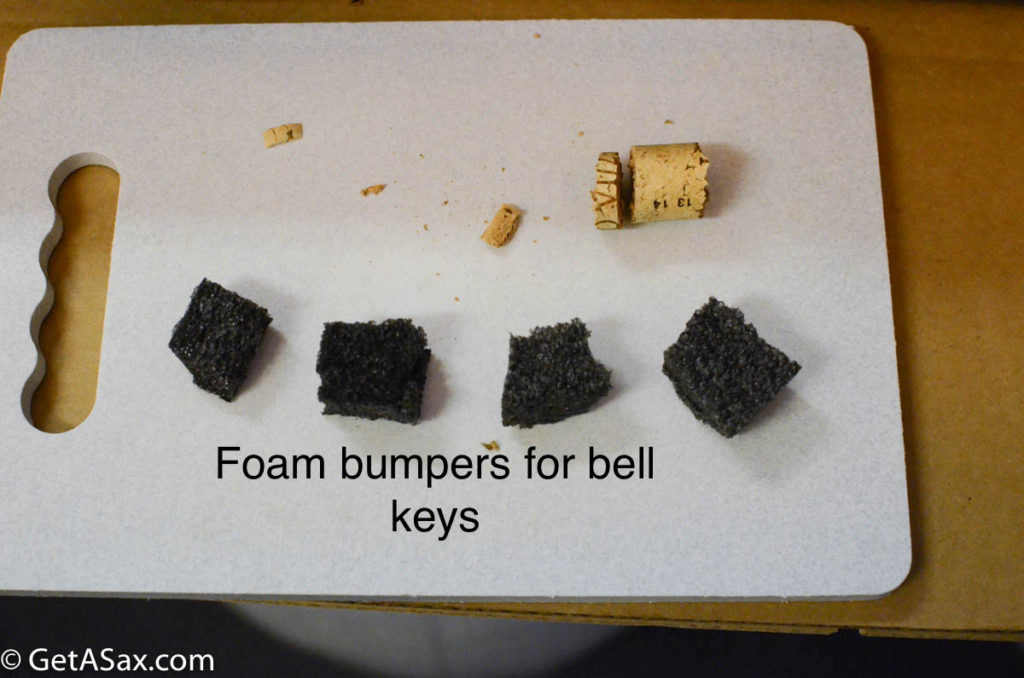
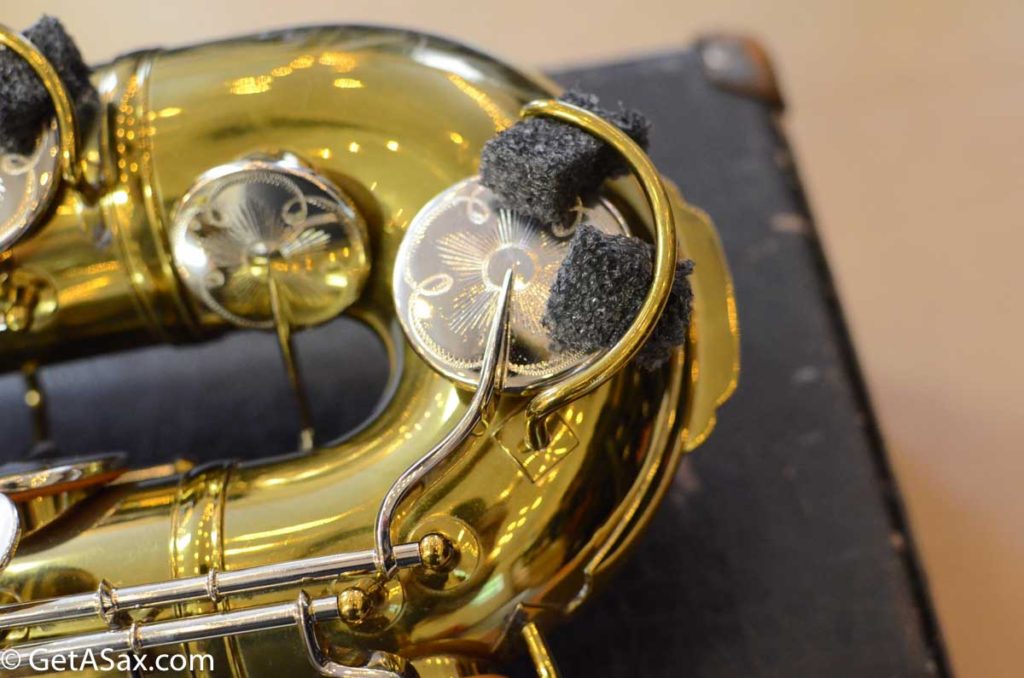

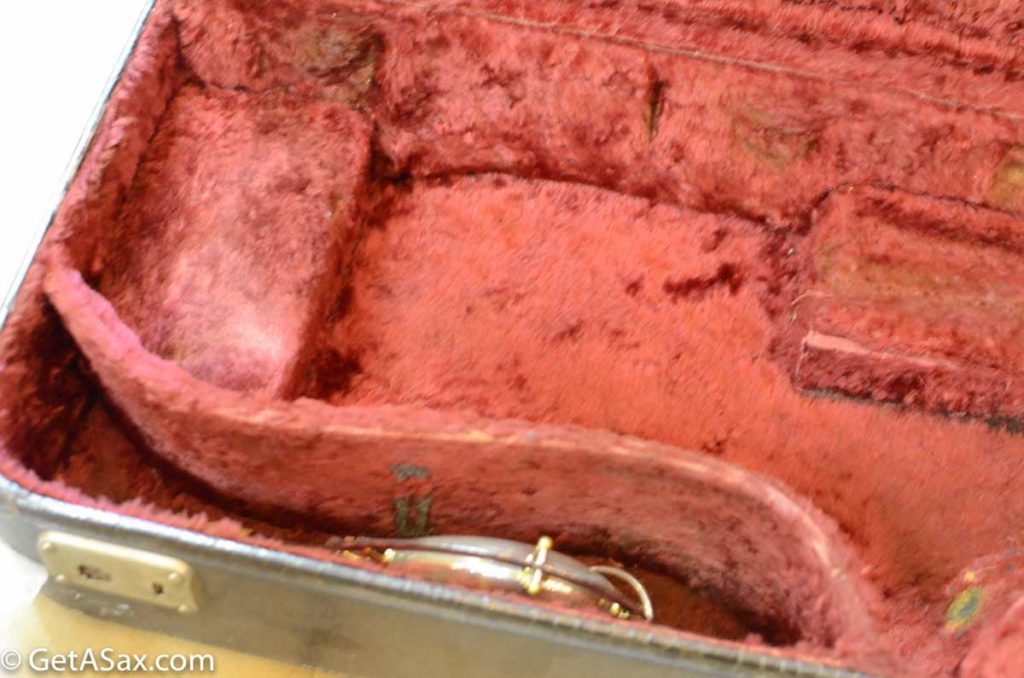
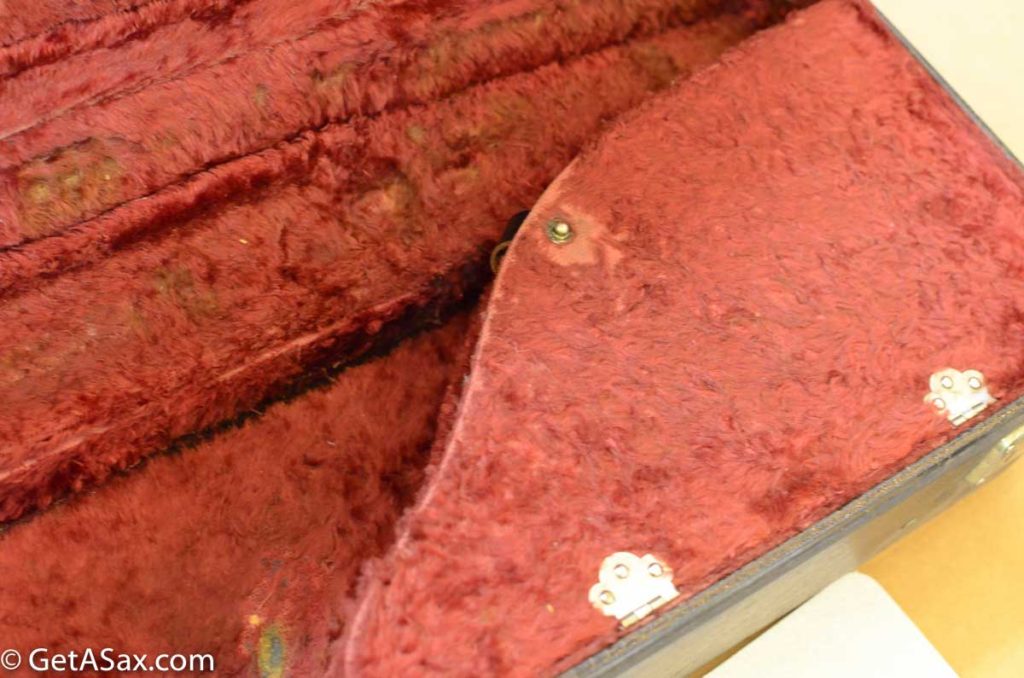
Getasax,
You and I have shipped quite a few expensive instruments back and forth. You know how hard I try to prevent damage, and I appreciate the extensive care you have taken when shipping horns to me.
Sometimes it takes me hours to safely pack a saxophone. All I can say to others is, IT’S WORTH IT! If a horn gets damaged, even more hours will be spent to correct the damage, and sometimes a wonderful horn that has survived decades without a scratch can be destroyed. Don’t be the person who destroys a great saxophone.
Thanks, Brian. This is very clearly spelled out and a great resource for anyone shipping an instrument.
Thanks Jason! I hope it helps a lot of people prevent shipping damage.
Excellent website you have here, i do agree on some
things however, but not all.
Very well done Brian.
Pretty much the way that I do it,except I never blocked the key pads etc,but the box,packaging is the way that i ship it,with a double wall carboard box!
When sending a horn, always best to ship it the proper way..
My best regards,
from Ontario ,Canada
Mario Malette
Will music stores package my instruments for shipping?
Usually not. The FedEx Office stores have a ‘fragile pack’ service that is pretty good.
I would also suggest removing the thumbscrew for the neck. Often this projects outward and has no extra padding around it. If the thumbscrew gets bent, it an also affect the shape of the receiver (put it out of round)
This is a wonderful article that should help ensure that our horns arrive safely during shipping. Clearly and smartly written. Well done.
WOW!!
Everything I will ever need to know about packing a Sax. I’m just placing My 1957 mark vi Alto for sale and I’d hate to have it wrecked in shipping ( if it gets sold)